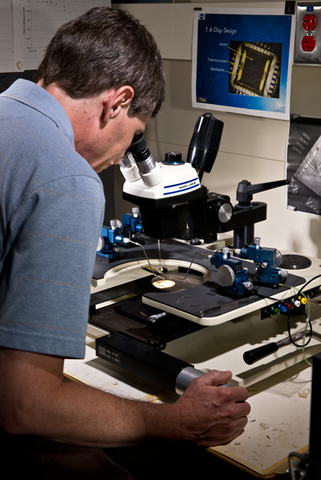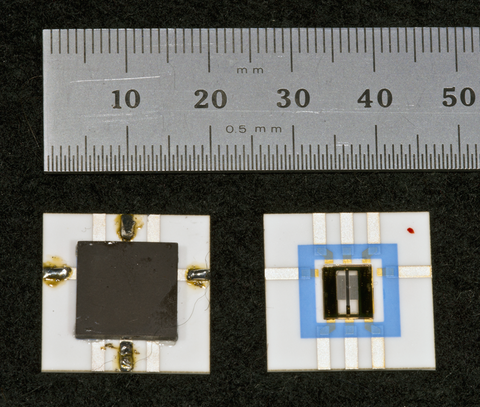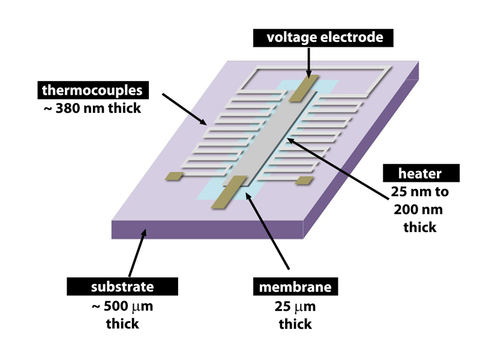New AC Voltage Devices: Factor of Three Improvement in Uncertainty

Thomas Lipe examines a multijunction thermal converter (MJTC) chip. The new design reduces measurement uncertainties by a factor of three.
After years of effort and scores of iterations, PML researchers have developed a new generation of devices that can reduce the uncertainties in ac voltage measurements by a factor of three.
The improved design "has exceptional properties over a large range of voltages and frequencies," says Thomas Lipe of PML's AC-DC Difference Project in the Quantum Measurement Division. "Those capabilities have allowed us to reevaluate the matrix NIST uses for determining uncertainty in these measurements, resulting in significant improvements at all voltage and frequency levels."
The current NIST primary standards for ac voltage metrology are multijunction thermal converters* (MJTC), approximately 4 mm by 7mm in size and fabricated on microchips. They operate by measuring the amount of heat generated in a tiny metal microstructure (the "heater") – first by a dc voltage known to very high precision, and then by an unknown ac voltage applied to the same structure. The difference, measured by an array of about 120 thermocouples placed next to the heater, is recorded at stepwise intervals across a scale of voltages up to 1000 V and frequencies as high as 100 MHz.
"That ac-dc difference," Lipe says, "is what we measure in calibrating customers' instruments, and it is the quantity that the customer uses to correct the numbers it is getting from its own calibrator or voltmeter."
There are numerous properties that affect uncertainties in MJTCs, and Lipe's project has addressed nearly all of them on its way to the new design. One is the chip material. The MJTCs introduced as primary standards at NIST in 2005 were fabricated on a silicon substrate. Silicon works best at frequencies from 10 Hz to 1 MHz, and potentials from 0.25 V to 2 V. It is less satisfactory for higher frequencies owing to substantial dielectric loss; in addition, physical design factors that improve performance at the low end of the audio range – 10 Hz and below – are detrimental at high frequencies.
There is, however, a growing demand in avionics and other areas for better accuracies at frequencies from tens to hundreds of MHz, and higher. So the PML researchers have been working for years** to improve performance in that range, trying different configurations and materials at NIST's Center for Nanoscale Science and Technology, where the fabrication is done. Around 2007, they started testing fused quartz (which has lower dielectric loss than silicon), but found it brittle and prone to microfractures. "We were breaking more wafers than we successfully fabricated," Lipe says.
In 2009, however, they began to concentrate on fused silica, and found that it had superior characteristics and, importantly, could be made thicker. "It also enabled us to increase the thickness of the metal structures to about 400 nanometers," Lipe says. "The thicker the metallization, the lower the resistance. That improves the accuracy of both the heater and the thermocouples."

Having arrived at an acceptable design in 2009, the researchers focused on changing different component properties, such as the heater width and thickness, and fine-tuning various features to improve performance. "We're now on wafer number 22," Lipe says. "Starting about number 18, we started noticing that the high-frequency errors were small. For a traditional thermal transfer standard at 100 MHz and about 1 volt, it's not unusual to have ac-dc differences of well over 1 percent. We started seeing differences of about 0.36 percent.
"We had expected that, and we will soon cut that figure in half. But we didn't expect that the low-frequency performance would be so good. Our differences are essentially zero at frequencies below 1 MHz. The thermal efficiency is so good we can use them from 1 volt to 5 volts because the voltage coefficient doesn't change. That's another thing we hadn't expected."
Expanded range is critically important to the measurement process. A primary standard may, for example, be optimized for minimal uncertainties in the range of 0.25 V to 2 V, and 10 Hz to 1 MHz. Within that range, AC-DC differences vary as little as 1 microvolt per volt.
In order to determine the performance of a device outside this low-uncertainty "sweet spot" – e.g, all the way from a few mV to 1000 V – metrologists use "range-to-range scaling," in which successive measurements are taken for voltage ranges in increments of 2 V, 3 V, 5 V, 10 V, 20 V, and so on up to 1000 V, and in comparable increments for lower voltages. Higher and lower frequencies are measured the same way.

"That's a major improvement with our new MJTCs," Lipe says. "Because of their wider useful voltage range and their near-uniform AC-DC difference at frequencies from 1 MHz to about 100 MHz, we can eliminate fully one-third of the steps in the scaling process."
In addition, the researchers -- who in 2008 pioneered the use of AC Josephson voltage standards to calibrate thermal transfer standards at voltages as low as 2 mV -- have further integrated the quantum-based standard with the MJTC. Measurements made by the Josephson devices have uncertainties as much as an order of magnitude smaller than traditional range-to-range scaling.
"We expect that the new MJTCs, referenced to the ACJVS at 250 mV, will soon become the new everyday standards in the AC-DC Difference Project, offering primary standard accuracy in our working standards, and significantly improving the ac metrology program," Lipe says.
"Our new generation of devices won't dramatically change the time required for customer calibration, although we will spend less time recharacterizing our standards. But we expect that customers will want to take advantage of the substantially reduced uncertainties."
* The use of thermal converters for ac voltage metrology was introduced by Franck Hermach at the National Bureau of Standards in 1952.
** The work is supported, in part, by the Calibration Coordination Group of the Department of Defense project 546.

